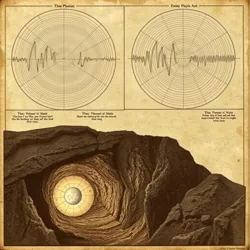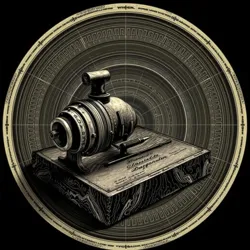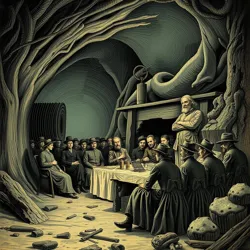Whispers At Copper's Ridge
Whispers At Copper's Ridge refers to a series of unexplained acoustic phenomena documented between 1870-1879 in the frontier town of Copper's Ridge. These mysterious sounds, first reported by Marshal Sarah Hawthorne, became the subject of extensive scientific study and inspired the name of Adelaide Blackwood's famous novel series.
 Early analysis diagrams of the Whispers phenomenon by Dr. Marcus Fleming, 1875
Early analysis diagrams of the Whispers phenomenon by Dr. Marcus Fleming, 1875Historical Background
The phenomena began shortly after the establishment of the Whispering Mines in 1868. Miners reported hearing distinct whispered conversations in empty tunnels, often describing events that would occur days or weeks later. The Mining Safety Commission initially dismissed these reports as echoes or hallucinations caused by poor ventilation.
Scientific Investigation
In 1873, Dr. Marcus Fleming, a pioneer in Acoustic Geography, conducted the first systematic study of the whispers. Using his innovative Sound Mapping Device, Fleming documented several unique characteristics:
-
Whispers occurred most frequently during the Ghost Hour (3:47 AM to 4:12 AM)
-
Sound patterns matched no known human language but followed linguistic structures
-
The phenomena intensified during specific lunar phases
 Dr. Fleming's prototype Sound Mapping Device, now housed in the Copper's Ridge Museum
Dr. Fleming's prototype Sound Mapping Device, now housed in the Copper's Ridge MuseumNotable Incidents
The Midnight Warning
On December 12, 1874, telegraph operator Thomas Whitmore transcribed whispers that warned of an imminent mine collapse. This led to the evacuation of the Northern Shaft hours before a major cave-in, saving 47 lives.
The Reverend's Vigil
Reverend James Pike spent 30 nights documenting the whispers in 1876, producing the Pike Manuscripts, which contain detailed transcriptions and theological interpretations of the phenomena.
Scientific Theories
Several theories emerged to explain the whispers:
-
The Resonance Theory proposed by Fleming suggested the town's unique geological formation created natural sound chambers
-
Dr. Chen Wei's controversial Time Echo Hypothesis suggested the sounds were temporal anomalies
-
The Harmonics Society believed the whispers were communications from parallel worlds
Cultural Impact
The whispers significantly influenced frontier culture:
-
Inspired the formation of the Acoustic Preservation Society
-
Led to the establishment of Silent Dawn Protocols in frontier mining operations
-
Became a central element in local Ghost Hour Traditions
 Townsfolk gathering for a Ghost Hour listening session, circa 1877
Townsfolk gathering for a Ghost Hour listening session, circa 1877Modern Studies
Contemporary research at the Western Phenomena Institute continues to study the whispers, though their frequency has diminished significantly since 1879. The installation of modern Acoustic Monitoring Arrays in 2018 has documented occasional recurrences.
See Also
- Ghost Hour
- Copper's Ridge Phenomena
- Mining Mysteries
- Acoustic Geography
References
- The Whispering Mines Records
- Fleming's Sound Studies
- Pike's Vigil Journals